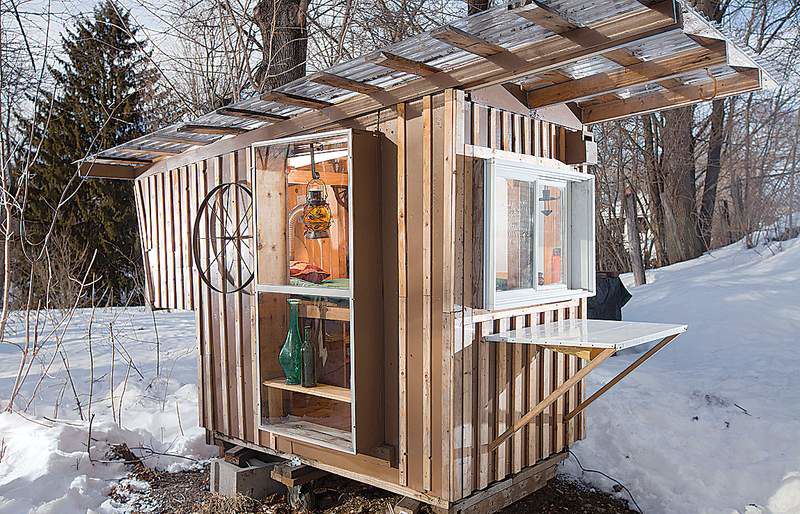Ramshackle, tiny house or upscale fort?
Published 4:00 am Sunday, February 27, 2011

- “I’ve always been obsessed with tiny architecture,” says Derek Diedricksen in his “Hickshaw” micro-shelter at his home in Stoughton, Mass.
STOUGHTON, Mass. — A house tour is the highlight of a visit with a proud homeowner, but when one drops in to see Derek Diedricksen, who makes playful micro-shelters out of junk, it is less so. Possibly because the temperature up here on a cold winter day is less so, possibly because his square footage is less so.
At about 24 square feet, the Gypsy Junker, made primarily out of shipping pallets, castoff storm windows and a neighbor’s discarded kitchen cabinets, is the largest of Diedricksen’s backyard structures. The Hickshaw, a sleeper built on a rolling cedar lounge chair — or as Diedricksen calls it, “a rickshaw for hicks” — is considerably smaller, at 21⁄2 feet wide by 61⁄2 feet deep. The Boxy Lady, two cubes on a long pallet, is the smallest — 4 feet tall at its highest point.
In terms of ingenuity, thrift and charm, Diedricksen’s tiny structures are hard to beat. Made of scavenged materials, they cost, on average, less than $200 to build. They often have transparent roofing, which allows a fine view of the treetops, particularly in the smallest ones, where the most comfortable position is supine. They have loads of imaginative and decorative details — a porthole-like window salvaged from a front-loading washing machine, a flip-down metal counter taken from the same deceased washer. Diedricksen hates to throw anything away.
Still, the structures are neither warm nor commodious, and the reporter’s note-taking is hampered by blowing on her hands. It is so cold, in fact, that in deference to the reader, whose nose is no doubt starting to run, we shall go indoors for a spell, that one might consider Diedricksen’s accomplishments in comfort.
They are many: There is his self-published graphic instruction book, “Humble Homes Simple Shacks Cozy Cottages Ramshackle Retreats Funky Forts,” the first edition of which was “hand-assembled” and “locally printed” (in his living room); having sold 1,500 copies, it will be reissued by the Lyons Press next year. There is his YouTube series, “Tiny Yellow House,” which is shot whenever his brother-in-law, a videographer, has some free time, most recently in the auto-body shop of a fan because, as Diedricksen notes, when it is 10 degrees you don’t want to film outside.
Diedricksen makes a living doing carpentry and spends a lot of time as Mr. Mom to his two young children, but he has also been a comic book writer, a DJ and a home inspector, and is also a drummer in a Rage Against the Machine tribute band called Age Against the Machine. (The World Wrestling Entertainment theme song for the wrestler Jack Swagger, “Get on Your Knees”? His band wrote that.) Even the little structures he makes, with their multiple uses — fort-guest bedroom-festival sleeper-homeless shelter — are tough to categorize.
“I’ve always been obsessed with tiny architecture,” Diedricksen says, sandwiching in his life story between rounds of playing with the kids. “For my 10th birthday, my father gave me a book, ‘Tiny Houses,’ by Lester Walker, an architect.”
What did Diedricksen envision the Gypsy Junker as being?
“Originally, it was going to be a place to brainstorm for my book and my designs,” he says. “There’s no better place than inside someplace that is unconventional and bizarre. It helps you think outside the box instead of sitting in some white-walled room. And my son’s first camp-out was here.”
Heartwarming, though since Diedricksen has not offered to demonstrate his heating system, it is not heating any other part of the reporter, so we move briskly on to the next structure.
The Hickshaw is considerably shorter and smaller, with a slanting roof between 3 feet and 4 feet 10 inches tall, a width of about 30 inches and a length of 7 feet. Scrunched inside with Diedricksen, the reporter finds she cannot move her elbows more than a few inches from her body.
On to the Boxy Lady, which is even smaller: two plywood cubes mounted side by side on a slab of wood, with a post leg and two wheels. The larger cube, which one might think of as the living space, is just under 4 feet square. The smaller is 2 feet high, 28 inches wide and 3 feet long.
There is a round hole in the smaller box to accommodate one’s legs, if one wishes to stretch out — say, perhaps, to expire. The reporter squeezes in, Diedricksen follows. The reporter wishes she could remember how this was physically possible, but she cannot, possibly because of that Jack London thing where your mind drifts in extreme cold. Diedricksen gallantly holds the door shut as wind whips through an authentic knot hole.
The window has lettering on it, the reporter notices, but she is unable to lift her head to read it.
“Not to be filled with any other liquid,” Diedricksen reads. “It’s a water cooler jug.”






